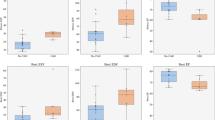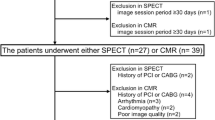Abstract
Backgrounds
Prediction of left ventricular functional recovery is important after myocardial infarction. The impact of quantitative perfusion and motion analyses with gated single-photon emission computed tomography (SPECT) on predictive ability has not been clearly defined in multi-center studies.
Methods
A total of 252 patients with recent myocardial infarction (n = 74) and old myocardial infarction (n = 175) were registered from 25 institutions. All patients underwent resting gated SPECT using 99mTc-hexakis-2-methoxy-isobutyl isonitrile (MIBI) and repeated the study after revascularization after an average follow-up period of 132 ± 81 days. Visual and quantitative assessment of perfusion and wall motion were performed in 5,040 segments.
Results
Non-gated segmental percent uptake and end-systolic (ES) percent uptake were good predictors of wall motion recovery and significantly differed between improved and non-improved groups (66 ± 17% and 55 ± 18%, p < 0.0001 for non-gated; 64 ± 16% and 51 ± 17% for ES percent uptake, p < 0.0001). The area under the curve of receiver operating characteristics curve for non-gated percent uptake, ES percent uptake, end-diastolic percent uptake and visual perfusion defect score was 0.70, 0.71, 0.61, and 0.56, respectively. Sensitivity and specificity of percent uptake were 68% and 64% for non-gated map and 80% and 52% for ES percent uptake map. An optimal threshold for predicting segmental improvement was 63% for non-gated and 52% for ES percent uptake values.
Conclusion
Segmental 99mTc-MIBI uptake provided a useful predictor of wall motion improvement. Application of quantitative approach with non-gated and ES percent uptake enhanced predictive accuracy over visual analysis particularly in a multi-center study.


Similar content being viewed by others
References
Dilsizian V, Arrighi JA, Diodati JG, Quyyumi AA, Alavi K, Bacharach SL, et al. Myocardial viability in patients with chronic coronary artery disease. Comparison of 99mTc-sestamibi with thallium reinjection and [18F]fluorodeoxyglucose. Circulation 1994;89:578–87.
vom Dahl J, Altehoefer C, Sheehan FH, Buechin P, Schulz G, Schwarz ER, et al. Effect of myocardial viability assessed by technetium-99m-sestamibi SPECT and fluorine-18-FDG PET on clinical outcome in coronary artery disease. J Nucl Med 1997;38:742–8.
Tamaki N, Kawamoto M, Takahashi N, Yonekura Y, Magata Y, Nohara R, et al. Prognostic value of an increase in fluorine-18 deoxyglucose uptake in patients with myocardial infarction: comparison with stress thallium imaging. J Am Coll Cardiol 1993;22:1621–7.
Lucignani G, Paolini G, Landoni C, Zuccari M, Paganelli G, Galli L, et al. Presurgical identification of hibernating myocardium by combined use of technetium-99m hexakis 2-methoxyisobutylisonitrile single photon emission tomography and fluorine-18 fluoro-2-deoxy-D-glucose positron emission tomography in patients with coronary artery disease. Eur J Nucl Med 1992;19:874–81.
Bax JJ, Wijns W, Cornel JH, Visser FC, Boersma E, Fioretti PM. Accuracy of currently available techniques for prediction of functional recovery after revascularization in patients with left ventricular dysfunction due to chronic coronary artery disease: comparison of pooled data. J Am Coll Cardiol 1997;30:1451–60.
Arnese M, Cornel JH, Salustri A, Maat A, Elhendy A, Reijs AE, et al. Prediction of improvement of regional left ventricular function after surgical revascularization. A comparison of low-dose dobutamine echocardiography with 201Tl single-photon emission computed tomography. Circulation 1995;91:2748–52.
Udelson JE. Choosing a thallium-201 or technetium 99m sestamibi imaging protocol. J Nucl Cardiol 1994;1:S99–108.
Udelson JE, Coleman PS, Metherall J, Pandian NG, Gomez AR, Griffith JL, et al. Predicting recovery of severe regional ventricular dysfunction. Comparison of resting scintigraphy with 201Tl and 99mTc-sestamibi. Circulation 1994;89:2552–61.
Acampa W, Cuocolo A, Petretta M, Bruno A, Castellani M, Finzi A, et al. Tetrofosmin imaging in the detection of myocardial viability in patients with previous myocardial infarction: comparison with sestamibi and Tl-201 scintigraphy. J Nucl Cardiol 2002;9:33–40.
Maes AF, Borgers M, Flameng W, Nuyts JL, van de Werf F, Ausma JJ, et al. Assessment of myocardial viability in chronic coronary artery disease using technetium-99m sestamibi SPECT. Correlation with histologic and positron emission tomographic studies and functional follow-up. J Am Coll Cardiol 1997;29:62–8.
Marzullo P, Sambuceti G, Parodi O. The role of sestamibi scintigraphy in the radioisotopic assessment of myocardial viability. J Nucl Med 1992;33:1925–30.
Kang WJ, Lee DS, Paeng JC, Kim KB, Chung JK, Lee MC. Prognostic value of rest 201Tl-dipyridamole stress 99mTc-sestamibi gated SPECT for predicting patient-based clinical outcomes after bypass surgery in patients with ischemic left ventricular dysfunction. J Nucl Med 2003;44:1735–40.
Germano G, Erel J, Lewin H, Kavanagh PB, Berman DS. Automatic quantitation of regional myocardial wall motion and thickening from gated technetium-99m sestamibi myocardial perfusion single-photon emission computed tomography. J Am Coll Cardiol 1997;30:1360–7.
Berman DS, Kiat H, Friedman JD, Wang FP, van Train K, Matzer L, et al. Separate acquisition rest thallium-201/stress technetium-99m sestamibi dual-isotope myocardial perfusion single-photon emission computed tomography: a clinical validation study. J Am Coll Cardiol 1993;22:1455–64.
Berman DS, Abidov A, Kang X, Hayes SW, Friedman JD, Sciammarella MG, et al. Prognostic validation of a 17-segment score derived from a 20-segment score for myocardial perfusion SPECT interpretation. J Nucl Cardiol 2004;11:414–23.
Kumita S, Kumazaki T. Assessment of left ventricular function with 99mTc-MIBI gated myocardial SPECT using 3 head rotating gamma camera (in Japanese). Kaku Igaku (Jpn J Nucl Med) 1994;31:43–52.
Shirakawa S, Hattori N, Tamaki N, Fujita T, Yano S, Kudoh T, et al. Assessment of left ventricular wall thickening with gated 99mTc-MIBI SPECT—value of normal file (in Japanese). Kaku Igaku (Jpn J Nucl Med) 1995;32:643–50.
Giubbini R, Rossini P, Bertagna F, Bosio G, Paghera B, Pizzocaro C, et al. Value of gated SPECT in the analysis of regional wall motion of the interventricular septum after coronary artery bypass grafting. Eur J Nucl Med Mol Imaging 2004;31:1371–7.
Taki J, Higuchi T, Nakajima K, Matsunari I, Hwang EH, Bunko H, et al. Electrocardiographic gated 99mTc-MIBI SPECT for functional assessment of patients after coronary artery bypass surgery: comparison of wall thickening and wall motion analysis. J Nucl Med 2002;43:589–95.
Fleiss J, Cohen J. The equivalence of weighted kappa and the intraclass correlation coefficient as measures of reliability. Educ Psychol Meas 1973;33:613–9.
DeLong ER, DeLong DM, Clarke-Pearson DL. Comparing the areas under two or more correlated receiver operating characteristic curves: a nonparametric approach. Biometrics 1988;44:837–45.
Bax JJ, Maddahi J, Poldermans D, Elhendy A, Cornel JH, Boersma E, et al. Sequential 201Tl imaging and dobutamine echocardiography to enhance accuracy of predicting improved left ventricular ejection fraction after revascularization. J Nucl Med 2002;43:795–802.
Marzullo P, Sambuceti G, Parodi O, Gimelli A, Picano E, Giorgetti A, et al. Regional concordance and discordance between rest thallium 201 and sestamibi imaging for assessing tissue viability: comparison with postrevascularization functional recovery. J Nucl Cardiol 1995;2:309–16.
Bisi G, Sciagra R, Santoro GM, Rossi V, Fazzini PF. Technetium-99m-sestamibi imaging with nitrate infusion to detect viable hibernating myocardium and predict postrevascularization recovery. J Nucl Med 1995;36:1994–2000.
Kawano H, Soejima H, Kojima S, Kitagawa A, Ogawa H. Sex differences of risk factors for acute myocardial infarction in Japanese patients. Circ J 2006;70:513–7.
Saito M, Fukami K, Hiramori K, Haze K, Sumiyoshi T, Kasagi H, et al. Long-term prognosis of patients with acute myocardial infarction: is mortality and morbidity as low as the incidence of ischemic heart disease in Japan. Am Heart J 1987;113:891–7.
Nakajima K, Nishimura T. Inter-institution preference-based variability of ejection fraction and volumes using quantitative gated SPECT with 99mTc-tetrofosmin: a multicentre study involving 106 hospitals. Eur J Nucl Med Mol Imaging 2006;33:127–33.
Kaul S. There may be more to myocardial viability than meets the eye!. Circulation 1995;92:2790–3.
Author information
Authors and Affiliations
Corresponding author
Appendix
Appendix
List of the hospitals for MIBI myocardial viability research group follows.
Sapporo Medical University Hospital, Hokkaido University Hospital, Wakkanai City Hospital, Hokko Memorial Hospital, Kushiro City Medical Association Hospital, Yamagata University Hospital, Hoshi General Hospital, Toho University Omori Hospital Center, Toranomon Hospital, Sakakibara Commemoration Hospital, Shonan Kamakura General Hospital, Tomioka General Hospital, Nagoya Daini Red Cross Hospital, Social Insurance Hamamatsu Hospital, Kansai Medical University Takii Hospital, National Cardiovascular Center, Kyoto University Hospital, Kyoto University Hospital, Kanazawa University Hospital, Koseiren Takaoka Hospital, Fukui Prefectural Hospital, Hokuriku Central Hospital of Japan Mutual Aid Association of Public School Teachers, Kanazawa Cardiovascular Hospital, Saiseikai Saijo Hospital, National Hospital Organization Ehime National Hospital, Saiseikai Kumamoto Hospital
Rights and permissions
About this article
Cite this article
Nakajima, K., Tamaki, N., Kuwabara, Y. et al. Prediction of functional recovery after revascularization using quantitative gated myocardial perfusion SPECT: a multi-center cohort study in Japan. Eur J Nucl Med Mol Imaging 35, 2038–2048 (2008). https://doi.org/10.1007/s00259-008-0838-6
Received:
Accepted:
Published:
Issue Date:
DOI: https://doi.org/10.1007/s00259-008-0838-6




